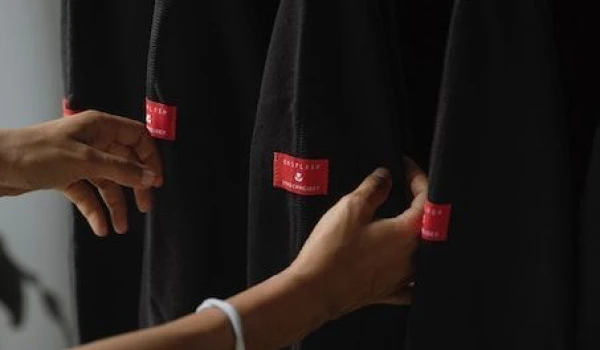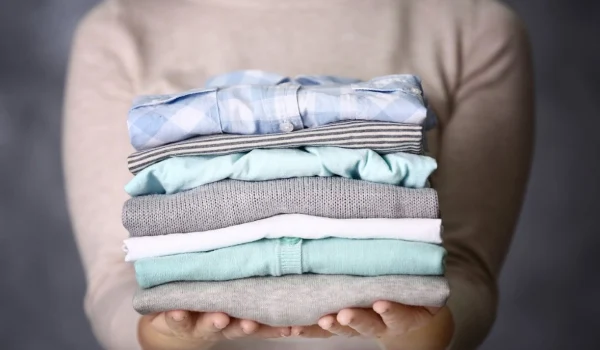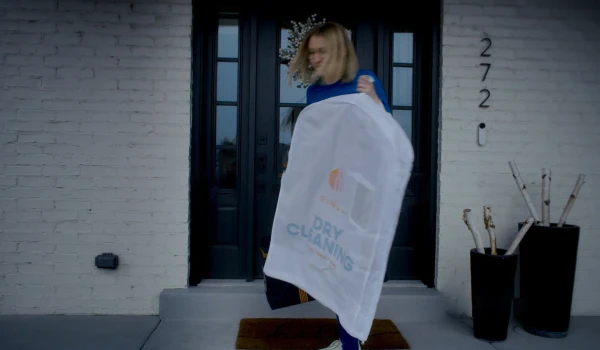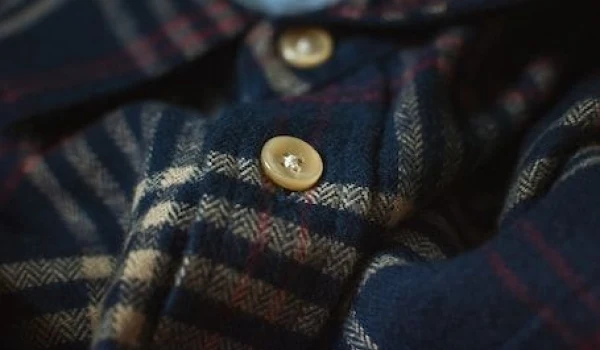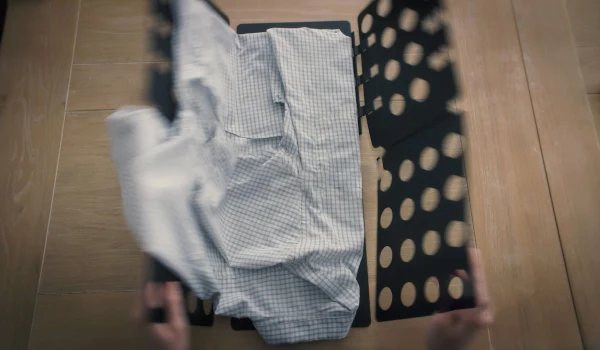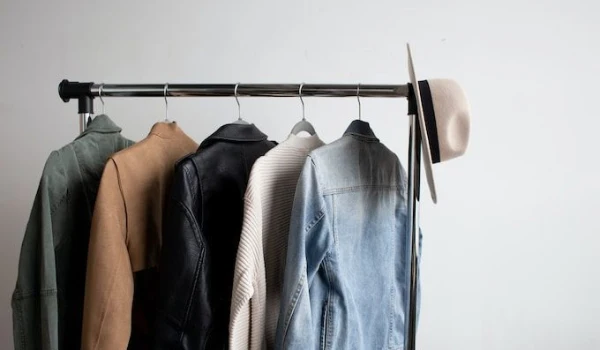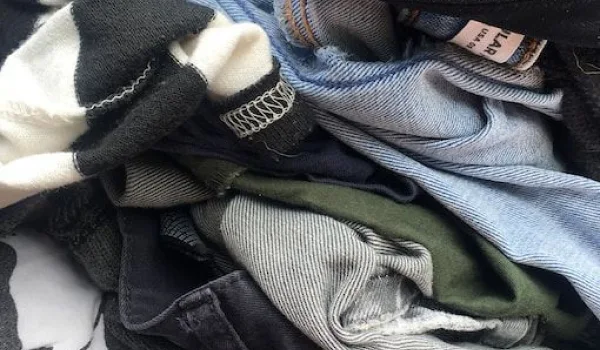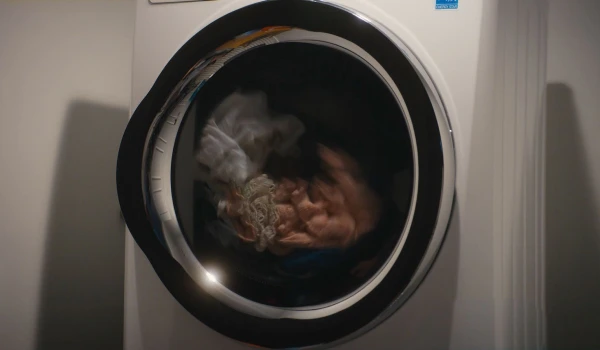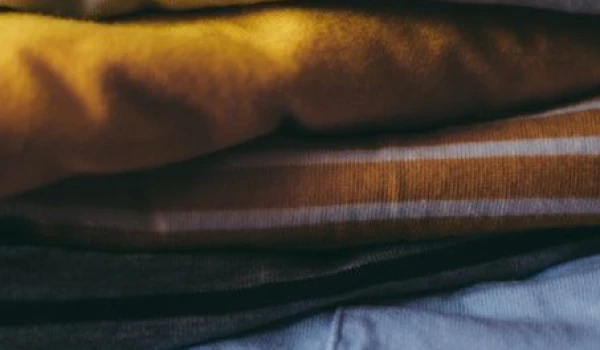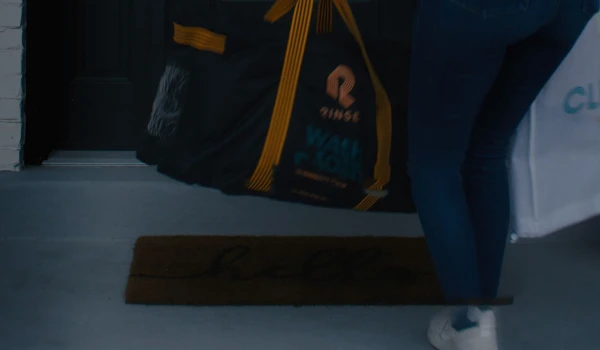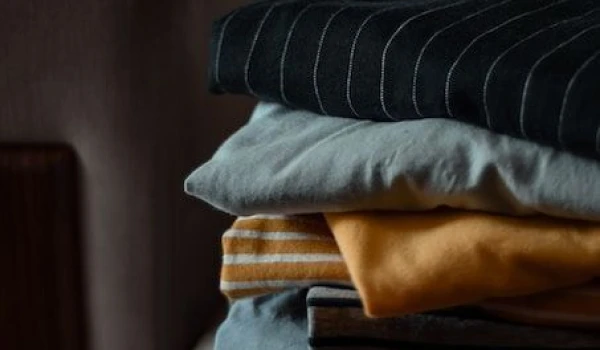Care
Clothing care tips to make your wardrobe last

This article will explore the implications of getting dog hair in your clothes and how it can affect your clothing and washing machine. It will also include different ways to get dog hair out of clothes and prevent this from happening again.
Introduction
Dealing with dog hair on clothes is a common challenge for pet owners. While our furry friends bring joy and companionship, their shedding can leave your wardrobe and washing machine beleaguered with pet hair. Not only does this affect the appearance and feel of your clothing, but it can also lead to clogs and reduced efficiency in your laundry appliances. Dog hair tends to cling stubbornly due to static electricity, making it challenging to remove dog hair effectively.
This article serves as your comprehensive guide to removing pet hair from clothes and preventative measures to keep your laundry pet-hair-free. We'll explore a variety of methods, from using a lint roller to employing anti-static spray, to ensure your clothes and washing machine remain in pristine condition. Get ready to tackle pet hair removal with ease and efficiency!

Can Dog Hair Get to Your Washing Machine?
When you have a pet, dog hair on clothes is almost a given. However, the implications of these furry remnants extend beyond just your wardrobe. In the laundry process, dog hair can end up in your washing machine and dryer, potentially leading to clogs and other issues.
Dog hair, especially from breeds that shed heavily (we're looking at you, corgis), can accumulate in your washing machine. Over time, this accumulation can clog the filters and pumps. In the dryer, hair sticks to the lint trap, which needs regular cleaning to maintain efficiency. Cat hair and other pet hairs have similar effects.

How to Get Dog Hair out of Clothes
Here are effective ways to get dog hair out of your clothes and prevent future occurrences:
1. Use a Lint Roller
A lint roller (or sticky tape) is an essential tool for pet owners. It's simple to use and effective at picking up fur from various types of clothes. Roll it over your garments to capture the hair. For larger clumps of fur, you might need to go over the area multiple times.
2. Pre-Treat with a Rubber Broom or Squeegee
Before washing, use a rubber broom or squeegee to brush over the surface of your clothes. This can help loosen the fur and make it easier to remove during the wash cycle. It's an especially useful technique for heavier garments where pet hair tends to embed deeper into the fabric.
3. Use Rubber Gloves
Rubber gloves are surprisingly effective at removing pet hair. Put on a pair of gloves and lightly dampen them. Run your hands over your clothes, and the fur will clump up, making it easy to remove. This method works well on most natural fabrics.
4. Use Dryer Sheets
Dryer sheets (or fabric softener sheets) can help reduce static, which makes fur stick to clothes. Toss a sheet in with your laundry during the drying cycle. The sheet will help loosen the hair, which then gets caught in the lint trap.
5. Add Vinegar to the Washing Machine
Adding a half cup of white vinegar to your washing cycle can help loosen pet hair from clothes. Vinegar is a natural fabric softener and helps break down the dander and undercoat residues that make the hair cling to fabrics.
6. Post-Wash Care
After washing, use a wool dryer ball in the dryer. These balls help collect pet hair and reduce static cling, which makes hair stick to clothes and the sides of the dryer. In addition, regularly clean the lint trap of your dryer – a damp squeegee or rubber glove can be used to collect hair from the trap effectively.

How to Prevent Dog Hair from Getting on Your Clothes
Pets are beloved members of our families, but dealing with dog shed on your clothes can be a frustrating aspect of pet ownership. Here’s how you can proactively prevent dog hair from getting on your clothes:
1. Wash Pet Bedding Separately
One of the primary sources of pet hair on clothes is from pet bedding. It’s essential to regularly wash your pet’s bedding but always do so separately from your clothes. Washing pet bedding with your garments can transfer fur and dander onto your clothes. Using a vacuum cleaner or a rubber broom to loosen any pet hair from the bedding before washing can also be effective.
2. Regular Pet Grooming
Routine grooming is essential for reducing the amount of hair that pets shed. Regular brushing removes loose fur and undercoat, minimizing the amount that ends up on your clothes and around your home. Investing in a good-quality brush or glove designed for pet grooming can make a significant difference.
3. Use Furniture Covers or Blankets
Pets often have favorite spots to lounge, which can often be on furniture where their hair can transfer to your clothes. Using washable furniture covers or blankets in these areas can catch pet hair before it spreads. Simply wash these covers regularly to keep fur accumulation at bay.
4. Create Pet-Free Zones
Designating certain areas of your home as pet-free can help keep your clothing hair-free, especially items made of natural fabric that easily attract hair. Keeping closet doors closed and placing clothes immediately in a hamper or a closet after wearing them can prevent fur from clinging to them.

Keep Your Clothes Dog Hair-Free with Rinse
For pet owners, keeping clothes free of dog hair can be a relentless challenge. While home remedies and cleaning techniques like using a vacuum or a squeegee are helpful, they often require consistent effort and time.
This is where Rinse steps in as your ultimate laundry solution. Rinse offers professional cleaning services that efficiently tackle pet hair, ensuring your clothes stay fresh and free from fur.
Rinse understands the complexities involved in removing pet hair from various fabric types. Not only that, but we also offer the ultimate convenience by offering pickup and delivery services right to your door. Whether you need traditional laundry or dry cleaning, we got you covered.
Discover the difference with Rinse, your go-to solution for hassle-free laundry care. Visit our website or app and schedule your service today. With Rinse, pet hair in your laundry is one less thing to worry about!
Contact us at Rinse today to see our skill in action.

Introduction
The hospitality industry has become quite competitive in recent years. Hotels have to step up their game to get those five-star reviews on Google Business and Booking.com.
One way hotels do this is by keeping their amenities in pristine condition. You don't see a yellowish or moldy hotel towel when you stay at a five-star hotel, do you? The same goes for hotel bedding, too.
But have you ever thought about how hotels keep their towels white and spotless? Let's look at ways to keep a towel soft and clean with a few cleaning hacks.

8 Ways Hotels Keep Their Towels White
The good news is there's no one magic trick involved in keeping towels spotless. Simply adopt the following cleaning tips to keep your towels soft and bright white.
Bleach White Towels
It shouldn't come as a surprise that bleach is involved in keeping hotel towels white. Hotels use oxygen or chlorine bleach, depending on the type of fabric and stains.
Oxygen bleach is a form of hydrogen peroxide and releases oxygen to remove stains without damaging the fabric. You can use it as a pre-treatment before washing your towels, too. Only use bleach if you're washing a white sheet or towel. Bleaching colored garments will fade their color.
Use Optimal Water Temperature
Do you use cold water to wash your towels? That's probably why they've started to lose their color.
Towels have to be washed in hot water. Check the care label to see the maximum temperature the fabric can handle.
Hot water does a lot more than just cleaning the towels. It also sanitizes them and removes bacteria or body oils. It also leaves the towel feeling fluffy.
Use Quality Laundry Detergent
Hotels use a heavy-duty laundry detergent to wash their towels. These detergents usually come in powder formulations. They contain phosphates, which help dissolve stains and dirt better than liquid detergents.
In some cases, hotels may use a fabric softener to give towels a fluffier feel and reduce static electricity.
Avoid Overloading the Washing Machine
A common mistake people make when washing towels is overloading the machine. Since your towels don't have enough room in the washer tub to circulate, they don't get properly cleaned.
Hotels avoid this by using industrial-sized washers that have plenty of space for towels to move around. They also run multiple loads rather than trying to cram everything into one.
Pre-Soak Towels
What do you do when your bath towel or wash towel has a stubborn stain? You throw it in the washer and hope for the best.
Hotels don't do that. They pre-soak their towels in vinegar or oxygen bleach. After soaking, they wash the towels with hot water and a regular detergent.
They may also use a fabric conditioner to soften the towels. Similarly, if a towel smells musty, the cleaners at the hotel may use baking soda to deodorize it.
Air Dry or Use Low Heat
Here's another common mistake: using high heat to dry towels. When you use high heat, you risk shrinking the towel or damaging its fibers.
Have you ever noticed how your towels get dingy and rough after a few washes? That's because the heat breaks down the fibers.
When drying towels, hotels use a low heat setting. Alternatively, they sometimes reduce the drying time in the dryer and then air dry the towels until they're completely dry.
Air drying is the preferred method because it allows the towels to fluff up without any heat damage. You can do the same at home, too. Hang your towels in the sun or near an open window.
Treat Stains Promptly
Housekeeping at hotels changes towels and linens regularly. They keep an eye on any stains on the towels and treat them promptly.
If a white sheet or towel is stained, they use a commercial stain remover or a natural stain-fighting solution like lemon juice or vinegar. That's why the hotel bedding and towels always look spotless.
You can use the same method at home, too. Suppose you accidentally stain the towel with makeup. Don't delay the clean-up because the stain will set in.
Take a clean cloth and blot the stain with vinegar. Rinse with cold water and then wash the towel as usual to remove any residue. For a white towel, you can also use bleach to remove stubborn stains.
Hire Professional Laundering Services
Oftentimes, hotels don't want to go through the hassle of bleaching, spot-cleaning, pre-soaking, washing, during, and so on. So, they outsource the laundering to a professional laundry service like Rinse.
Here's how it helps:
-
Best-In-Class Cleaning: Rinse offers top-notch laundering services to gyms, hotels, and other organizations.
-
Real-Time Communication: Rinse provides real-time updates on the status of the laundry as it goes through the cleaning process. Hotels know when to expect clean linens and towels.
-
Customer Offerings: At Rinse, we understand that different customers have different needs. We customize our services to meet every hotel's specialized laundry needs.
-
Single Point of Contact: A hotel may have multiple locations. Rinse offers a single point of contact for all locations to manage and coordinate laundering services conveniently.
More importantly, Rinse's eco-friendly practices mean there is no harmful chemical waste involved in the laundering process.

Maintaining Towels White in the Long Run
One-time cleaning is often not even. You want to maintain the whiteness of towels in the long run. Here are some strategies for it.
Rotate the Towels Regularly
If you keep using one side of the towel, it will start to wear out. After a few months of regular usage, you'll end up with an uneven white shade on your towels.
Avoid this by rotating the towels regularly. This way, you'll use both sides of the towels, and they'll wear out evenly.
Store Towels Properly
Don't just throw your towels in a pile after washing them. Instead, store them in a cool and dry place. Also, fold them neatly and keep them in a designated area to prevent discoloration.
Always let your towels dry completely before storing them to avoid mildew growth.
Follow Care Label Instructions
Different towels have different fabric compositions and care instructions. Follow the care label instructions for washing and drying the towels.
If the care label has come off, go to the manufacturer's website to find the appropriate instructions. You can also drop them an email for detailed instructions.
Wash Towels Periodically
Do your towels only come across the laundry machine once every few months? That's a no-no. Regular cleaning is imperative for whiter and softer towels.
Schedule a day to wash all your towels at least once a week to remove accumulated dirt and bacteria.

Want Your White Towels To Shine? Outsource Your Laundry
Hotels are already outsourcing their laundry. Why shouldn't you follow suit?
At Rinse, we're experts in laundry services. We know how to tackle stains on a white towel and how to deal with colored ones. Similarly, we're familiar with the care tips for different fabric types.
Besides towels, we can also wash and fold your other garments. All you need to do is schedule a pickup, and we'll pick up your dirty load right from your doorstep. You can request our services through our app or website.
We also offer dry cleaning services for your special clothes that might need extra care. Just let us know your requirements, and we'll do the rest for you.
Contact us at Rinse today to see our skill in action.

Have laundry or dry cleaning to do?
Rinse picks up, cleans and delivers 7 days a week. Amazingly awesome. Ridiculously simple.

This upcoming guide provides an in-depth exploration of towel care, focusing on how often you should wash your towels. The content emphasizes the significance of regularly washing bath towels and outlines the potential consequences of neglecting their hygiene. Additionally, it discusses the importance of replacing towels over time.
Introduction
Towel hygiene is an often overlooked aspect of personal care, yet it holds paramount importance. Towels, whether it's your bath towel, hand towel, or kitchen towel, are integral to our daily hygiene routines. However, they can become a breeding ground for germs and bacteria if not washed regularly.
This guide focuses on the crucial question: How often should you wash your towels? Understanding the right frequency of washing your towels is not just about maintaining a sense of cleanliness; it's about safeguarding your health and enhancing the lifespan of the towel itself.

The Importance of Washing Your Bath Towels
Regularly washing your bath towels is essential for numerous reasons, ranging from health benefits to the fabric's longevity. Here are the key advantages of keeping your towels clean:
1. Preventing the Spread of Germs
Every time you use a towel, it collects skin cells and moisture and can harbor bacteria. Regular washing eliminates these contaminants, reducing the risk of germ transmission. Laundry detergent, and in some cases, chlorine bleach or oxygen bleach, can effectively sanitize towels, keeping them fresh and hygienic.
2. Maintaining Skin Health
Dirty towels can irritate your skin and exacerbate skin conditions. Washing your towels with a gentle laundry detergent helps remove irritants and keeps them soft, ensuring they are safe for your skin. Avoid overusing fabric softener, as it can reduce towel absorbency.
3. Extending Towel Lifespan
Regular washing keeps towels in optimal condition. Using the right detergent and avoiding harsh chemicals like bleach (except for white towels) can prolong their lifespan. Laundry stripping, an occasional deep-cleaning method, can remove residue and musty odors.
4. Enhancing Towel Softness and Fluffiness
Over time, towels can lose their softness. Regular washing with a suitable detergent and occasionally using vinegar as a laundry booster can help keep your towels fluffy and pleasant. Avoiding excessive fabric softener and dryer sheets can also maintain their absorbency.
5. Preventing Odors and Mustiness
Towels can develop an unpleasant smell if left damp for too long. Regular washing and proper drying prevent this issue. Ensure towels are completely towel dry before putting them in the laundry basket or folding.
6. Keeping Colors Bright and Stain-Free
Regular laundering can help maintain the vibrant color of your towels and prevent stains from setting in. Using OxiClean or a similar color-safe bleach alternative can be effective for keeping colored towels looking their best.

How Often Should I Wash My Bath Towels?
The frequency of washing your bath towels is crucial for maintaining hygiene and comfort. Generally, it's recommended to wash towels after every three to four uses. Factors influencing this include the towel's exposure to moisture, its use in high-humidity environments like bathrooms, and individual hygiene needs.
Some Towels Need More Frequent Washing
Certain types of towels and specific situations require more frequent laundering due to increased accumulation of dirt, oils, or bacteria:
1. Kitchen Towel
Kitchen towels are exposed to food residues, spills, and frequent handling. They should be washed more regularly, ideally after each use or daily, to prevent the growth of germs and bacteria.
2. Gym Towel
Gym towels come into contact with sweat and gym equipment, making them prone to germ accumulation. It's advisable to wash these towels after every use to maintain hygiene.
3. Towels Used by People with Sensitive Skin
Individuals with sensitive skin or skin conditions should wash their towels more frequently. This helps remove skin cells, dander, and any residue that irritates the skin.
4. Hand Towels
People use hand towels in the kitchen or bathroom several times per day. They should be washed every one to two days to keep them clean and hygienic.
5. Towels in Humid Climates
In humid climates, towels may not dry completely between uses and can develop a musty smell. In such cases, towels should be washed more frequently to prevent mildew growth.
6. Washcloths
Washcloths used for the face or body should be washed after each use since they accumulate skin cells, oils, and bacteria more quickly due to their direct contact with the skin.

What Could Happen if You Don’t Wash Your Towels?
Neglecting your towels' cleanliness can lead to many issues impacting hygiene and health. We have alluded to some of these problems above, but we will explore the consequences of not regularly washing your towels here in more detail.
When towels are used, they absorb moisture and collect skin cells. This environment becomes ideal for bacteria and mold growth if not washed regularly. According to microbiologists, damp towels can harbor a significant number of microbes, and these can transfer back to your skin during subsequent uses. This can lead to skin irritations and infections, particularly if you have cuts or wounds.
Unclean towels can also become a source of unpleasant odors, with lingering moisture causing a musty or sour smell. Regular washing and proper drying are essential to prevent this. A dryer sheet can help maintain your towels' fresh scent and softness.
Another consequence of not washing towels is the reduced absorbency. Over time, residue from body oils and products can build up in the fabric, making even the best bath towel less effective. This is where laundry stripping, an intensive cleaning method, can be beneficial to remove this buildup and restore the towel's absorbency.
In terms of laundry care, using your washing machine correctly is crucial. Overloading can prevent towels from being cleaned effectively. It's crucial to wash towels at the temperature the towel manufacturer recommends and to use a suitable laundry detergent. After washing, towels should be dried thoroughly in a dryer or air-dried to prevent any remaining dampness, which can lead to bacterial growth.

Elevate Towel Care with Rinse
Ensuring that your towels are hygienically washed and maintained doesn't have to be a daunting task. Rinse offers a convenient and reliable solution to keep your towels in their best condition. Our expert cleaning services ensure that each wash towel receives the care it deserves, from your plush best bath towel to the essential hand towel.
Utilizing proven washing techniques, Rinse effectively removes build-up and residue. Our professionals understand the importance of drying towels thoroughly to prevent mustiness, ensuring every clean towel is soft and ready for your next shower. We ensure your towels are cleaned thoroughly and gently with high-quality laundry detergents and the right settings on our washing machines.
Transform your towel care routine with Rinse. Let us handle the chore of keeping your towels clean, so you can enjoy the comfort and hygiene of fresh towels after every shower without any effort. Experience the Rinse difference today – where clean, hygienic towels are just a service away.
Contact us at Rinse today to see our skill in action.

The upcoming article explores the challenge of removing pasta sauce stains from clothing. It outlines the unique difficulties spaghetti sauce poses and provides a detailed guide with steps for effective stain removal. The essential materials required are highlighted, and common questions around stain removal are addressed as well.
Indulging in spaghetti with tomato sauce can quickly turn into a wardrobe disaster when a vivid splatter lands on your beloved light-colored shirt. And are you wondering how to get tomato sauce out of a white shirt? While it may seem like a catastrophe initially, timely action and the right techniques can salvage your clothing. The methods for removing tomato sauce stains are effective and surprisingly simple.
Despite the reputation of spaghetti sauce as a formidable stain, many people mistakenly assume the stain is irreparable. In truth, successfully removing a spaghetti sauce stain is achievable, provided you employ the correct cleaning methods.
This article will explore practical steps to rescue your clothes from the clutches of pasta sauce mishaps.

Why Is Spaghetti Sauce So Hard to Remove?
Unraveling the mystery behind the resilience of spaghetti sauce stains involves understanding the unique properties that make them particularly stubborn. Here's why spaghetti sauce poses a formidable challenge for stain removal:
Tomato Concentration
Spaghetti sauce owes its staining prowess to a concentrated amount of tomato, surpassing even raw tomato juice in pigmentation. The compounds responsible for the vibrant red hue of tomatoes are adept at binding to clothing fibers.
Fiber-Binding Nature
The same compounds that give tomatoes their rich color demonstrate a remarkable affinity for binding to the fibers in our clothing. This characteristic, coupled with the acidic nature of tomatoes, can accelerate the wear and tear of fibers, potentially causing irreversible damage.
Deep Fiber Binding
Any stain penetrating and binding to clothing fibers rather than merely resting on the surface becomes inherently more challenging to remove. This deep-seated adherence increases the likelihood of a permanent setting.
While spaghetti sauce stains may be notorious, there's hope for successful removal. Understanding the unique challenges posed by the composition and pigmentation of spaghetti sauce allows us to adopt effective stain-removal strategies, ensuring a triumphant victory over even the most tenacious stains.

What You'll Need
To successfully tackle pasta sauce stains, assembling a few essential tools and materials is crucial. This comprehensive list ensures an effective and gentle approach to stain removal, safeguarding your garments from the stubborn marks of tomato-based mishaps. For an extra boost, consider incorporating white vinegar, known for its natural fabric-softening properties, into your stain removal arsenal.
1. Stain Remover
The first line of defense against pasta sauce stains is a dedicated stain remover designed for food stains. You can choose a product that aligns with your fabric type and carefully follow the manufacturer's instructions. This initial step sets the foundation for effective stain elimination.
2. White Cloth or Paper Towels
White cloths or paper towels are pivotal in the initial phase of stain removal. These materials are essential for blotting and absorbing excess sauce. White cloth is imperative to prevent the risk of colored cloth transferring dyes onto the stained fabric.
3. Cold Water
Cold water becomes a crucial ally in preventing the stain from setting. Could you quickly rinse the stained area under cold running water to flush out as much sauce as possible before proceeding with further treatment? This immediate action helps mitigate the impact of the stain.
4. Mild Dish Soap
Choosing mild dish soap as your stain-fighting ally provides a gentle yet potent approach. Apply a small amount directly onto the pasta sauce stain, utilizing either your fingers or a soft bristle brush. This method effectively breaks down the oils and proteins in the sauce, simplifying the removal process. The dish soap's gentle touch ensures efficient stain treatment without compromising the fabric's integrity.
5. Hydrogen Peroxide
Harness the stain-lifting power of hydrogen peroxide to combat stubborn pasta sauce stains. After the initial rinsing, directly apply hydrogen peroxide to the stain. Please check fabric color safety carefully, as hydrogen peroxide can bleach certain materials. This effective treatment enhances stain removal, but mindful application ensures a balance between potency and fabric protection during the stain-elimination process.
6. Liquid Laundry Detergent or More Dish Soap
For more intensive stain removal, turn to liquid laundry detergent or dish soap. You can quickly apply the chosen cleaning agent to the affected area and gently rub the fabric together. This technique intensifies the cleaning power, effectively addressing tougher stains. The meticulous application of liquid laundry detergent or dish soap ensures a thorough treatment, improving the chances of successfully eliminating persistent stains from the fabric.
7. Soft Bristle Brush or Toothbrush
A soft-bristle brush or toothbrush becomes a handy tool for gently scrubbing the stain without causing damage to the fabric. This meticulous approach is particularly useful when working the soap or stain remover into the fibers, ensuring thorough coverage.

How To Get Pasta Sauce Out Of Clothes: 8 Steps
Would you be willing to be on a mission to rescue your clothes from a pasta sauce mishap? Follow this comprehensive 8-step guide for effective and meticulous stain removal.
1. Act Quickly
The key to successful stain removal is swift action. When the pasta sauce touches your clothing, please keep the stain from setting. Time is of the essence, so don't delay initiating the stain removal process.
2. Scrape off Excess Sauce
Prioritize stain removal by delicately scraping off excess pasta sauce with a blunt utensil or spoon's edge. Take care to avoid spreading the stain or damaging fibers. This step is crucial, especially for tackling stubborn grease stains that may accompany pasta sauce mishaps.
Removing the surplus sauce sets the stage for effective stain treatment, minimizing the potential for further damage or set-in stains.
3. Blot with White Cloth
In the crucial step of blotting with a white cloth or paper towel, gently press the material onto the stained area. Refrain from rubbing, which could drive the sauce deeper into the fabric. The purpose of blotting is to absorb the sauce effectively, lifting it away from the garment. This gentle technique prevents the further spread of the stain and promotes successful removal.
4. Rinse with Cold Water
You can head to the sink and rinse the stained area under cold running water. The cold water assists in flushing out the sauce from the fabric. Please ensure that the water runs from the backside of the stain to push it out rather than deeper into the fabric.
5. Apply Stain Remover
Liberally apply a stain remover specifically designed for food stains. Choose a product compatible with your fabric type and follow the manufacturer's instructions for application. Allow the stain remover to penetrate the fabric for the recommended duration.
6. Gentle Scrubbing
Use a soft-bristle brush or toothbrush to scrub the stain gently for tougher stains. This aids in working the stain remover into the fibers, enhancing its effectiveness. Be cautious to avoid aggressive scrubbing that may damage delicate fabrics.
7. Pre-Treat with Dish Soap
Pre-treat the stain with mild dish soap for additional stain-fighting power. Apply a small amount to the stain and gently work it with your fingers or a soft brush. The dish soap helps break down the oils and proteins present in the sauce.
8. Check Before Laundering
Before tossing the garment into the washing machine:
-
Double-check to ensure the stain is fully removed.
-
Inspect the stained area for any lingering traces.
-
If the stain persists, repeat the above steps before laundering to prevent setting the stain during the wash.

FAQs
Curious about conquering pasta sauce stains? Here are answers to some frequently asked questions to guide you through the stain removal process:
Can I use hot water to remove pasta sauce stains?
It's advisable to stick to cold water when treating pasta sauce stains. Hot water can set the stain by bonding the proteins in the sauce to the fabric fibers, making removal more challenging.
Are there specific fabrics that are more challenging to treat for pasta sauce stains?
Fabrics with intricate weaves or delicate fibers may pose more challenges in stain removal. It's crucial to exercise caution and opt for gentler methods with such fabrics to avoid damage during the stain removal process.
Can I use bleach to remove pasta sauce stains from white clothes?
While bleach may be effective for some stains, be very careful with pasta sauce stains. The acidic nature of tomatoes can react with bleach, potentially causing discoloration. It's recommended to opt for safer stain removal methods.
Are tomato sauce stains permanent?
Most tomato sauce stains are not permanent if treated promptly and correctly. Taking immediate action, using appropriate stain removers, and following the right steps can significantly enhance the chances of complete stain removal.

No Problem Pasta with Rinse
Say goodbye to pasta sauce stress with Rinse! Our expert laundry and dry cleaning services are your hassle-free solution for tackling stubborn stains. Trust Rinse's specialized techniques and expertise to effectively remove pasta sauce stains, leaving your clothes pristine and worry-free.
We understand the unique challenges of stains like tomato sauce and tailor our approach to ensure optimal results. With Rinse, the process is seamless and convenient – no more wrestling with DIY solutions. Enjoy the convenience of letting professionals handle the tough stains, leaving you with peace of mind and impeccably clean clothes.
Contact us at Rinse today and experience no problem pasta!

This article is an exploration of the effects and consequences of fabric softeners. It delves into the purpose of fabric softeners, discusses garment types that may not require softeners, and provides a balanced examination of the pros and cons. The piece aims to inform readers, enabling them to make informed decisions about fabric softener usage.
Introduction
Fabric softener, often hailed for its promise of cozy, fragrant clothes, has become a laundry essential for many. However, its seemingly harmless role in the quest for softer garments raises questions: Is fabric softener bad or truly a friend to all fabrics, or could its charm conceal potential drawbacks?
In this exploration, we unravel the mysteries of fabric softeners, scrutinizing their purpose and the types of fabrics that may not benefit from their touch.
This article aims to present a balanced view, shedding light on both the advantages and disadvantages, empowering readers to make informed choices about using fabric softeners in their laundry routine.

What Is Fabric Softener & What Does it Do?
Fabric softener, also known as fabric conditioner, plays a pivotal role in the laundry routine, contributing to the allure of soft, pleasantly scented clothes. Its purpose extends beyond mere fragrance, aiming to enhance the texture of fabrics and mitigate static issues.
When applied during the laundry cycle, fabric softener coats the clothing fibers, forming a protective layer that imparts a luxurious softness and makes your clothes fluffier.
This conditioning agent, perceptible to the touch, leaves the fabrics feeling smoother and contributes to their longevity. You can even enhance the results using a dryer sheet to remove static electricity and a wool dryer ball to keep each article separated during the tumble cycle.
What Does Fabric Softener Do?
It acts as a conditioner for your clothing and bedding, working magic during the laundry cycle. It doesn't tackle stains or serve as a fragrance; its formula contains waxy fatty acids. These positively charged fatty acids are drawn to the negatively charged clothing in the washing machine, lubricating the fibers and neutralizing the charge.
A dryer ball is often used to prevent the clothes from clumping together. The question then arises: Is fabric softener necessary for your laundry routine?
Using fabric softener results in a noticeable decrease in wrinkles, minimal static, and fabrics that feel irresistibly soft to the touch. After the wash, your clothes are enveloped with a fresh scent. Moreover, fragrance-free fabric softeners are available, providing all the benefits without the added scent.

Impact of Fabric Softeners on the Environment
Fabric softeners, though providing laundry benefits, pose significant environmental concerns.
Opting for eco-friendly solutions like biodegradable fabric softeners helps mitigate the environmental impact of traditional alternatives.
Traditional softeners, often petroleum-based, present challenges in terms of biodegradability during manufacturing. The combustion of petroleum contributes to harmful emissions, including carbon dioxide, a potent greenhouse gas.
Some liquid fabric softeners derive from palm oil, which, while high-yielding, has ties to deforestation. To address these issues, opting for sustainably sourced palm oil, certified by the Roundtable on Sustainable Palm Oil (RSPO), is crucial.
Potential Environmental Impact of Fabric Softeners
-
Chemical Compositions: Fabric softeners housing toxic elements like glutaral (glutaraldehyde), threaten marine life and introduce harmful substances into aquatic environments.
-
Biodegradability: Ingredients like Quats, prevalent in fabric softeners, resist natural degradation, particularly in water systems. This resistance to biodegradation raises concerns about the potential harm they can inflict on aquatic ecosystems, persisting in the environment.
-
Eco-Toxicity: Using dyes in fabric softeners, discharged during manufacturing, also disrupts aquatic ecosystems. This interference hinders crucial processes like plant photosynthesis, contributing to an overall negative impact on the environment and aquatic life.
Additionally, disposable dryer sheets laden with non-recyclable polyester and chemicals contribute to air pollution, emphasizing the need for eco-conscious alternatives.

Pros and Cons of Using Softener
In the quest for softness and to ensure that laundry smells good, the use of fabric softeners has advantages and disadvantages. Let's delve into the pros and cons associated with the use of fabric softeners.
Pros of Fabric Softener
We've already alluded that incorporating fabric softeners into your laundry routine reduces wrinkles and makes clothes softer, enhancing your washing machine experience. However, we go into more detail on the several advantages that using fabric softeners in your laundry routine can yield below:
-
Removes Static: Fabric softeners reduce or eliminate static, elevate the comfort of clothes, and ensure a more enjoyable wearing experience. Remember to use a dryer ball!
-
Prevents Wrinkles: A notable advantage of fabric softeners lies in their ability to contribute to smoother fabrics, diminishing the likelihood of wrinkles. This, in turn, simplifies the ironing process, making it less of a chore for users.
-
Adds Nice Scent: Fabric softeners go beyond functionality, introducing a delightful fragrance that enhances the freshness of laundered items, leaving clothes with a pleasing aroma.
-
Maintains Form: Softeners play a crucial role in preserving the shape and structure of clothing. This feature ensures that the fabrics retain their original look, appearing newer for an extended period.
-
Locks in Colors: Creating a protective layer, fabric softeners contribute to maintaining the vibrancy of colors. This protective measure helps prevent fading over time, preserving the aesthetic appeal of clothing items.
Cons of Fabric Softener
Despite their benefits, fabric softeners may have drawbacks beyond the environmental ones mentioned above, such as:
-
May Trigger Allergies: Some individuals may be sensitive to the chemicals in fabric softeners, leading to allergic reactions.
-
Not Compatible with All Fabrics: Certain fabrics, particularly moisture-wicking and flame-resistant materials, may not benefit from or can even be harmed by fabric softeners.
-
Builds Up on Clothes: Over time, fabric softeners can leave a residue on clothing, affecting their absorbency and breathability.
-
Preservatives and Dyes: Including preservatives and dyes in fabric softeners raises environmental and health concerns.
-
Petroleum-Based Product: Traditional fabric softeners, often petroleum-based, contribute to environmental issues due to their non-biodegradable nature.
Understanding these pros and cons empowers individuals to make informed decisions about incorporating fabric softening into their laundry routine.

6 Types of Garments That Don’t Need Fabric Softener
Fabric softeners may only be somewhat beneficial, especially for certain garment materials. Understanding which fabrics don't require or may even be negatively impacted by fabric softener is crucial for proper care.
1. Wools and Delicates
Wool and delicate fabrics like silk or lace often do not benefit from fabric softeners. These materials have soft fibers that can be damaged or distorted by the chemicals in softeners. Opting for gentle, specialized laundry detergents ensures the preservation of their texture and quality.
2. Swimwear
Typically made of synthetic materials like spandex or nylon, swimwear fairs better without fabric softeners. These fabrics rely on their specific properties, like elasticity, for optimal performance. Fabric softeners may compromise these qualities, affecting swimwear's snug fit and overall functionality.
3. Towels
Contrary to expectations, towels only sometimes thrive under the influence of fabric softeners. Softeners can leave a residue on towels, reducing their absorbency over time. To maintain the fluffy and effective nature of towels, it's advisable to skip the softener in the laundry cycle.
4. Linen
Linen, renowned for its natural breathability, thrives without fabric softeners. Its texture naturally refines with each wash, embodying a delicate softness. Liquid fabric softeners, particularly cationic ones, risk disrupting this innate softening process, potentially diminishing the unique qualities that make linen a preferred choice for those who appreciate its natural appeal and comfort.
5. Workout Clothes
Moisture-wicking fabrics commonly found in workout clothes are designed to manage sweat efficiently. Fabric softeners can compromise this functionality by clogging the fabric's pores, diminishing its ability to wick away moisture. You can skip the softener to ensure your workout gear retains its performance properties.
6. Baby Clothes
Baby clothes, often made from delicate materials and designed for sensitive skin, may not be ideal for fabric softeners. The chemicals in softeners may trigger allergies or skin irritation in infants. Opting for hypoallergenic laundry detergents ensures the gentle care that baby clothes require.

Fabric Care Redefined with Rinse
Experience a revolution in fabric care with Rinse – your expert in laundry solutions. Our laundry detergent, full of surfactants, goes beyond conventional cleaning, making clothes impeccably clean and exceptionally soft.
Moreover, Rinse is committed to sustainable practices for all laundry and dry cleaning orders. Not only that, but we offer the ultimate convenience by picking up your clothes and dropping them off sparkling clean right to your doorstep.
Trust Rinse to redefine fabric care in your washing machine or through our premium dry cleaning services.
Contact us at Rinse today to see our skill in action.

In the upcoming guide, we will delve into the commonality of makeup stains, followed by a practical exploration of effective ways to remove them from clothing. Additionally, we'll tackle the often-overlooked issue of carpet makeup stains, providing valuable tips to elevate your stain-fighting prowess.
Introduction
You put on a new dress for a night out with friends and accidentally drop liquid foundation on it. Sound familiar?
Makeup stains can be a hassle to get rid of, especially if it's waterproof makeup. But don't worry, we've got you covered with some simple tricks to remove makeup from clothes.

4 Effective Ways To Get Makeup Out Of Clothes
Getting makeup on clothes isn't an uncommon occurrence. Whether it's your powder foundation transferring to the collar of your shirt or the mascara staining the sleeve as you try to fix your hair, we've all been there.
Here are some helpful ways to remove different types of makeup stains from clothes.
How to Remove Foundation from Clothes
Foundations may be oil-based or oil-free and require different cleaning solutions and methods. Here's how to remove oil-free foundation from clothes:
-
Scoop the Excess: Take a spoon or butter knife and use it to scoop the foundation of your garment. Do not rub the stain, or it will become bigger. You can also blot the stain with a clean white cloth or paper towel to remove any extra product.
-
Apply Shaving Cream: Squeeze a small amount of shaving cream to the stain, covering it completely. Rub it in, then let it sit for 10 minutes. Afterward, rinse it off with cool water.
-
Put Rubbing Alcohol: Sometimes, the shaving cream alone doesn't suffice. In such cases, apply shaving cream on the stain again. Then, put 4 drops of rubbing alcohol on the shaving cream and rub the mixture with your finger. Let it sit for a few minutes and rinse off with cold water.
-
Use a Detergent: Pretreat the foundation stain with a heavy-duty laundry detergent. You can use a powder or liquid laundry detergent. After soaking your garment in it for 10 minutes, wash it as usual. Repeat this process as necessary.
For oil-based foundations, start with the same steps from above. Scoop the foundation and blot the area with a paper towel. Then, do the following:
-
Apply Dish Soap: Put a few drops of cool water on the stain to wet it. Then, squirt some dish soap onto the stain and rub it in. Let it sit for 10-15 minutes, then rinse off with cold water.
-
Pretreat: Pretreat the stain with a heavy-duty laundry detergent and let it sit for 10 minutes before washing as usual.
If you get powder foundation (more on powder below) on your clothes, do not rub, wipe, or dab the stain. Instead, blow it with your mouth or a blow dryer. Then, wet the stain a little and pour a few drops of dish soap on it. Rub the stained area gently with your fingers and rinse off the dish soap with cold water.
Pro Tip: Do not use any of these tips for clothes that say ''Dry Clean Only.'' Take these clothes to a professional cleaner.
How to Remove Lipstick from Clothes
Lipstick stains are among the most common and frustrating makeup stains. Luckily, we have a simple solution to remove these stains without damaging your clothes. Follow these steps for lipstick stain removal:
-
Remove Excess: Remove the extra lipstick from the stain using a spoon or dull knife.
-
Pretreat the Stain: Use a dry solvent to pretreat the stain. You can either use acetone or a mineral spirit. Put a few drops of this solvent on the stain and use a soft-bristled brush to rub it in.
-
Flush the Stain: Flush the stained area with isopropyl alcohol. It will remove the lipstick's color, too. If one flushing isn't enough, repeat this step.
-
Apply Dish Soap: Make a mixture of 10 ounces of water and a tablespoon of dish soap. Put this mixture in a spray bottle and spray it on the lipstick stain. Let it sit for 10-15 minutes.
-
Wash: Finally, wash the clothes as usual according to the fabric care instructions. You can also pretreat the lipstick stain with an enzyme detergent for better results.
How to Remove Mascara from Clothes
Waterproof mascara is generally harder to remove than regular mascara because of its staying power. However, you can still remove it from your clothes by following these simple steps:
-
Dissolve the Mascara: Take a makeup wipe and dab it on the mascara stain. It will loosen up the mascara, making it easier to remove.
-
Wipe the Other Side: Put a paper towel or clean cloth on a flat surface. Place your stained garment face down on the towel and dab the back of the stain with a makeup wipe to push the mascara through the fabric onto the towel.
-
Use Laundry Detergent: When you can't get any more mascara off, use a small amount of laundry detergent and rub it into the stain with your fingers. Let it sit for a few minutes before washing.
If you're dealing with a white cloth, you can also use bleach to remove makeup stains.
How to Remove Powder Makeup From Clothes
Be it setting powder or powder blush, these makeup products can easily leave stains on your clothes. Here's how to remove them:
-
Shake the Loose Powder Off: Start by shaking off as much powder from the stain as you can.
-
Pretreat: Use a mixture of dish soap or mild detergent and water to pretreat the stain.
-
Launder According to the Care Instructions: Follow the instructions on the care label of your garment to wash it properly. If the stain persists, repeat the process or try using a stain remover for stubborn stains.

How to Remove Makeup Stains From Carpets
Your clothes are not the only victims of makeup stains. Carpets can also fall prey to our makeup mishaps. The same goes for upholstery and other fabrics.
Here's the good news: the same methods that work for clothes often work for carpets, too.
Blotting with a Clean Cloth
Before you go on to make any cleaning potions, you should blot the stain. Try to gently remove as much of the makeup as you can without spreading it around.
Using White Vinegar Solution
Vinegar works for pretty much any type of stain, including those caused by your eye makeup or foundation.
You will need:
-
One tablespoon of white vinegar
-
Two cups of cold water
Mix the two ingredients in a spray bottle and spray the solution on the stain. Wait for a few seconds before washing the garment as usual.
Using a Dishwashing Liquid Solution
Make a solution of warm water and a few drops of dishwashing liquid. It's the perfect makeup stain remover for carpets and clothes.
Using Rubbing Alcohol
Rubbing alcohol works so well on stains because it breaks down the oils in makeup products. Don't go overboard with it, though. Only use a few drops at a time, and always test on an inconspicuous area first.

Additional Makeup-Removing Tips
If you're a habitual makeup stainer, here are a few tips to keep your clothes stain-free:
-
Act Quickly: If you let the stains set, the removal process instantly gets harder. So, don't wait for this to happen. Instead, act as quickly as possible. If you can't treat the stain right away, at least blot it with a damp cloth until you can wash it.
-
Pretreat Cuffs and Collars: Since collars are in close vicinity of the face, they're more susceptible to makeup stains, such as blush and foundation. Pretreat these stains with a stain remover or dish soap mixture before washing them.
-
Use Baby Wipes: If you're out and about, keep baby wipes in your bag. Use them for accidental makeup smudges on your clothes.
-
Use Micellar Water: We bet you thought micellar water only removes the makeup on your face. But it can do wonders for your clothes, too. Just pour some on a cotton ball and dab it on the stain for quick stain removal. Similarly, you can use a liquid eye makeup remover for smaller stains.
-
Blot, Don't Rub: Keep this rule in mind for all types of stains, not just makeup. Rubbing only sets the stain deeper; you don't want that. Instead, blot the stain gently.

Makeup-Free Garments With Rinse
Doing regular laundry is already tedious enough. Doing it twice to remove makeup stains is truly frustrating. Thankfully, Rinse comes to the rescue with its professional laundry service.
You just have to put your dirty laundry in a bag, and we'll pick it up from your place. We then use appropriate cleaning methods and solutions to restore your garments to their pristine condition.
Whether it's a delicate silk blouse or a cotton t-shirt, we know how every fabric has to be cleaned. We also offer dry cleaning services for fabrics you cannot put through a washer. So, if you've got a foundation stain on your prized blazer or a wine spill on your graduation dress, we can tackle those, too.
Scheduling a pickup is quite easy. You can do it through a quick text or get in touch with us through our website or app. We also offer Next-Day Rush options for urgent stains that need immediate attention.
Contact us at Rinse today to see our skill in action.
Topics
Rinse Drop
We offer pickup and delivery if you can’t be present between 8pm and 10pm.
Our Valet will pick up or deliver your order to your doorstep or concierge, at which point you’ll receive a text with a photo showing where your items were left.
You can enable Rinse Drop on any (or all) of your orders.

